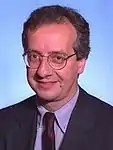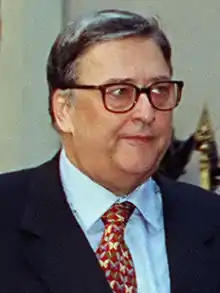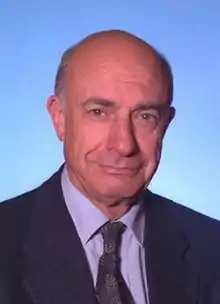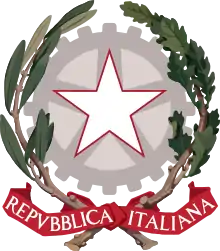Prodi I Cabinet
The Prodi I Cabinet was the 53rd cabinet of the Italian Republic. It held office from 17 May 1996 until 21 October 1998.
| Prodi I Cabinet | |
|---|---|
53rd Cabinet of Italy | |
 | |
| Date formed | 17 May 1996 |
| Date dissolved | 21 October 1998 (888 days) |
| People and organisations | |
| Head of state | Oscar Luigi Scalfaro |
| Head of government | Romano Prodi |
| No. of ministers | 22 (incl. Prime Minister) |
| Total no. of members | 23 (incl. Prime Minister) |
| Member party | PDS, PPI, RI, FdV, UD External support: PRC |
| Status in legislature | Centre-left coalition |
| Opposition party | FI, AN, LN, CCD, CDU |
| Opposition leader | Silvio Berlusconi |
| History | |
| Election(s) | 1996 election |
| Legislature term(s) | XIII Legislature (1996 – 2001) |
| Predecessor | Dini Cabinet |
| Successor | D'Alema I Cabinet |
Formation
On 21 April 1996, the Olive Tree won 1996 general election in alliance with the Communist Refoundation Party (PRC), making Romano Prodi Prime Minister of Italy. The Olive Tree's main component was the Democratic Party of the Left, which contained the bulk of the former Italian Communist Party. The PDS' Walter Veltroni, who ran in ticket with Prodi in a long electoral campaign, served as Deputy Prime Minister, and 15 other PDS ministers joined him in cabinet alongside 10 PDS junior ministers. It was the first time that (former) Communists had taken part in government since 1947.
Besides the external support of PRC, the coalition received the support also of some minor parties: the Italian Republican Party (PRI, social-liberal), The Network (social-democratic), the South Tyrolean People's Party (regionalist and Christian democratic) and some other minor parties which later merged with PDS.
The average age of the ministers was 55.9 years and 14 ministers has parliamentary experience.[1] The number of female ministers was three.[1]
Fall
The government fell in 1998 when the Communist Refoundation Party withdrew its support. This led to the formation of a new government led by Massimo D'Alema as Prime Minister. There are those who claim that D'Alema deliberately engineered the collapse of the Prodi government to become Prime Minister himself. As the result of a vote of no confidence in Prodi's government, D'Alema's nomination was passed by a single vote. This was the first and so far, the only occasion in the history of the Italian republic on which a vote of no confidence had ever been called; the Republic's many previous governments had been brought down by a majority "no" vote on some crucially important piece of legislation (such as the budget).
Party breakdown
- Independents: Prime minister, 3 ministers and 4 undersecretaries
- Democratic Party of the Left (PDS): 10 ministers and 16 undersecretaries
- Italian People’s Party (PPI): 3 ministers and 11 undersecretaries
- Italian Renewal (RI): 3 ministers and 4 undersecretaries
- Federation of the Greens (FdV): 1 minister and 3 undersecretaries
- Democratic Union (UD): 1 minister and 2 undersecretaries
- Segni Pact (Patto): 2 undersecretaries
- Italian Socialists (SI): 1 undersecretary
- Democratic Alliance (AD): 1 undersecretary
- Movement of Unitarian Communists (MCU): 1 undersecretary
- Republican Left (SR): 1 undersecretary
Composition of the Government
| Portrait | Office | Name | Term | Party | Undersecretaries | |
|---|---|---|---|---|---|---|
 |
Enrico Luigi Micheli (PPI) Arturo Parisi (Ind.)[lower-alpha 1] Giorgio Bogi (SR) (until 14 March 1997) | |||||
 |
||||||
 |
Piero Fassino (PDS) Rino Serri (MCU) Patrizia Toia (PPI) | |||||
 |
Franco Barberi (Ind.) Fabrizio Abbate (PPI) Giannicola Sinisi (PPI) Adriana Vigneri (PDS) Lucio Testa (RI) Angelo Giorgianni (RI) (until 13 March 1998) | |||||
 |
Giuseppe Ayala (UD) Franco Corleone (FdV) Antonino Mirone (Patto) | |||||
.jpg.webp) |
Laura Pennacchi (PDS) Giorgio Macciotta (PDS) Isaia Sales (PDS) Roberto Pinza (PPI) Filippo Cavazzuti (PDS) Dino Piero Giarda (Ind.) | |||||
.jpg.webp) |
Giovanni Marongiu (RI) Fausto Vigevani (PDS) Pierluigi Castellani (PPI) (since 21 Nov. 1996) | |||||
 |
Massimo Brutti (PPI) Gianni Rivera (Patto) | |||||
 |
Nadia Masini (PDS) Carla Rocchi (FdV) Albertina Soliani (PPI) | |||||
.jpg.webp) |
Antonio Bargone (PDS) Gianni Francesco Mattioli (FdV) | |||||
 |
Roberto Borroni (PDS) | |||||
.jpg.webp) |
Giuseppe Albertini (PDS) Giuseppe Soriero (PDS) | |||||
 |
Vincenzo Maria Vita (PDS) Michele Lauria (PPI) | |||||
 |
Umberto Carpi (PDS) Salvatore Ladu (PPI) | |||||
.jpg.webp) |
Antonio Pizzinato (PDS) Federica Gasparrini (RI) Elena Montecchi (PDS) (until 23 Feb. 1998) Alessandro Garilli (Ind.) (since 20 March 1998) | |||||
 |
Antonello Cabras (UD) | |||||
 |
Bruno Viserta Costantini (PDS) Monica Bettoni Brandani (PDS) | |||||
 |
Willer Bordon (AD) Alberto La Volpe (SI) | |||||
 |
Valerio Calzolaio (PDS) | |||||
.jpg.webp) |
(without portfolio) |
Sergio Zoppi (PPI) Ernesto Bettinelli (Ind.) (since 13 Feb. 1997) | ||||
 |
(without portfolio) |
Elena Montecchi (PDS) (since 23 Feb. 1998) | ||||
.jpg.webp) |
(without portfolio) |
|||||
.jpg.webp) |
(without portfolio) |
|||||
 |
— | |||||
- With delegation to information and publishing.
References
- De Giorgi, Elisabetta; Francesco Marangoni (2009). "The First Year of Berlusconi's Fourth Government: Formation, Characteristics and Activities" (PDF). Bulletin of Italian Politics. 1 (1): 87–109. Archived from the original (PDF) on 2013-12-30. Retrieved 2013-09-18.
